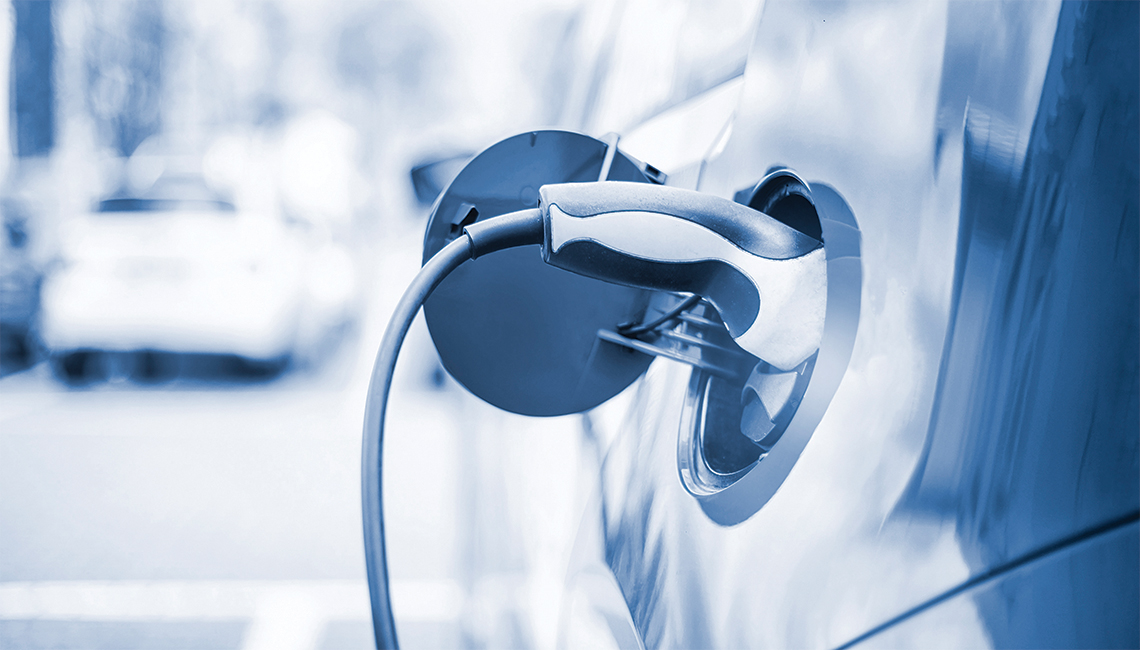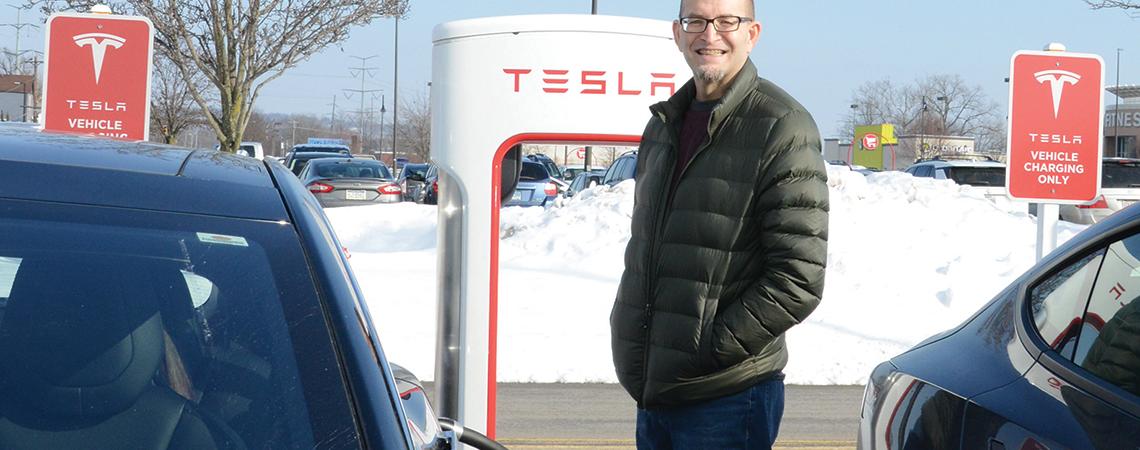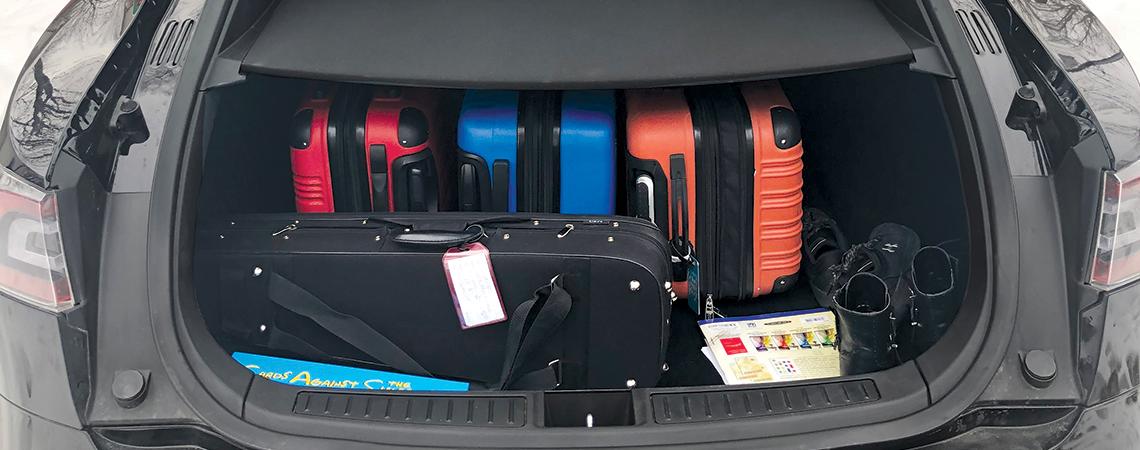In 2010, the first year that plug-in electric vehicles were commercially available, 300 were sold. The following year, that number climbed to almost 18,000, and by 2019, plug-in EV sales totaled 327,000 — about 2% of light-duty automobile sales that year.
There’s no question that electric vehicles’ popularity is on the rise. As drivers realize the advantages they present compared with gas-powered cars, and as those benefits become even more pronounced because of improving technology, it’s likely we’re going to see more and more of them on the road.
Ohio Cooperative Living Managing Editor Jeff McCallister
Electric cooperatives across the nation are preparing for the increased EV market share — especially as automakers begin rolling out electric pickup trucks and medium SUV models that are more popular with rural drivers.
Several Ohio co-ops have installed chargers at their offices, some offer rebates on home charging equipment, and all include calculators on their websites that help their members determine the potential savings if they switch to EVs from their current combustion model.
Ohio Cooperative Living’s staff decided to put an EV to the test: How close are EVs to being able to fully replace internal combustion cars when it comes to family use?
Newer EV models have an average full-charge range of more than 200 miles, so they’re more than capable of daily, in-town use for the average American driver — even in rural areas, the average U.S. driver travels only about 35 to 50 miles per day.
But what about those nonaverage days? I figured the real test would be an old-fashioned family road trip. Could an EV carry us to an out-of-state adventure? Eager to find out, I rented a 2018 Tesla Model S through the Turo car-sharing website and coaxed my wife and kids into a 400-mile, long-weekend trip to Nashville.
The first thing to report is that the Tesla is extremely fun to drive. The Model S can accelerate from 10 mph to well over the speed limit in the span of about half of a freeway entrance ramp (don’t ask how I know that). The Model S also had plenty of room for two adults, two teenagers, and our luggage for the weekend.
The second thing to report is that “range anxiety” is a real thing. The Tesla folks profess that the 2018 Model S gets between 270 and 320 miles on a full charge. Between the car’s internal mapping software and various apps that find chargers along a route, it’s relatively simple to plan stops between Columbus and Nashville that are easily within that range — even adding what I thought was a good bit of wiggle room — to make the trip without even thinking about running out of juice.
You know how automobile ads always include “your mileage may vary” in small print? As it turns out, an EV’s mileage can vary quite a bit.
We learned over the course of the long weekend that cruising at highway speeds (therefore not engaging the regenerative braking that helps prolong a charge), carrying a heavier load (I had two teenagers in the back seat), running the heater at full blast to cut the February freeze — not to mention using the rear heated seats, of which my kids were big fans — all takes a lot out of that projected mileage.
Of course, I don’t blame the EV entirely for my range anxiety; I probably should have made sure I knew the extent of that variance before I set out on the trip and then adjusted my stop schedule accordingly.
But that’s just it: When you’re driving an internal combustion car and realize you’re getting low on gas, there’s almost always a filling station around the next bend. For now, at least, charging stations are still fewer and farther between, so you can’t just say, “Oh, we’ll get the next one.” Beyond that, each charging stop requires a longer time investment than filling up a gas tank. The two charging stops we made between Columbus and Nashville and three stops on the way home added more than four hours to the round-trip travel compared to when we made the same trip in our Ford Fusion a couple of years ago.
The stop time is mostly manageable, though. The charging stations we used on the trip were situated in busy areas, close to things to do. The Cincinnati stop was in a parking lot between a Meijer and a Target store, and while my wife stayed in the car and happily read her book, the kids and I did a little snack shopping. They did not mind the 50-minute stop at all, and while we didn’t charge all the way to 100%, the range indicator told us we had more than enough to get to the next planned stop.
By the time we got to that stop, in Louisville, Kentucky, it was around dinnertime. The charging station was in a bank parking lot, with a nice Mexican restaurant nearby. Again, the charging time was time well spent; we ate a leisurely dinner and got a full charge that the on-board computer told me gave us 100 miles more range than we would need to get to Nashville — though that cushion quickly disappeared as the heater and hilly terrain pushed the battery to its limit. That last stretch took nearly the entire charge.
Driving around Nashville to do our touristy things was easy and fun — and all within about 25 miles, so we didn’t have to even think about the battery, which we charged on the hotel’s EV charger.
For the trip home, though (having learned my lesson), I allowed even more leeway in the car’s estimated range and added a stop in Bowling Green, Kentucky, to top off after only about 60 miles. We again found ourselves in a Meijer parking lot. The kids browsed the shelves for video games before we set off again.
Later, we had a late lunch/early dinner at a sub shop while the car fully charged in Louisville, but by the time we stopped again 113 miles later in Cincinnati, none of us were in the mood to do anything. Even with the Meijer and the Target right there, we sat playing on our phones for the 45 minutes it took to charge up to a reported 250-mile range for the remaining 110 miles of the trip.
Even with that much cushion, I spent the rest of the drive watching the range meter plummet and doing math in my head to try to guess how many miles’ worth of charge we actually had left. By the time we pulled into the driveway at home, the Tesla said it had only 38 miles remaining in the battery.
Despite the learning curve, my takeaway is that the fun factor, the reduction of my carbon footprint, and the dollars saved on fuel all easily overcame the trepidation about running out of battery power. As storage capacity and charge rates get better and more charging stations go up all the time, less thought will have to go into planning even cross-country trips.
The trip left me thinking that purchasing an EV of my own is probably in my future.
Road trip by the numbers
The last time I drove my family to Nashville, we took a gas-powered Ford Fusion, similar in size to the Tesla. How do the two vehicles compare?
Cost for fill-up
Tesla: Typically about $0.18–$0.25/kWh at a supercharger, closer to $0.13 on a home charger at regular utility rates. With a capacity of about 75 kWh, a full charge from completely empty would cost about $18.75 at a supercharger or $9.75 at a home charger.
Fusion: The national average gasoline price in February was $2.59 per gallon, so filling a Fusion’s 16.5-gallon tank from empty would have cost about $42.
Time for fill-up
Tesla: Tesla recommends only charging the battery to about 80% (about 25–35 minutes) in order to optimize both charging time and battery life. Our charging times on this trip were between 35 and 65 minutes.
Fusion: Fill-ups take only about 4 minutes.
Totals for the road trip
Tesla: Including topping off at a supercharger in Nashville before the trip home and a final charge before turning in the Tesla, we charged for a little more than five hours for just under 900 total miles, for around $75 (during more optimal conditions when the car’s range estimates are closer to actual performance, that figure could have been cut nearly in half).
Fusion: The Fusion gets about 30 miles per gallon combined city/highway, so we would need three stops for gas — about $120 and about 10 minutes total.












